If a single desk can trade all liquid instruments for an asset manager, it could see significant cost and process efficiencies. Lynn Strongin Dodds reports.
The distinction between asset classes from a trading perspective is blurred at the highly-liquid end of the spectrum, argue some traders, allowing a single desk to trade all liquid instruments regardless of asset class.
A 2018 report by Alignment Systems and FactSet entitled Evolution of the Multi-Asset Trading Desk, found, “Many buy-side firms with a centralised dealing desk have a number of ‘low-touch’ orders to which traders cannot add value” which it recommended should be sent for automated execution and passed downstream to settlement functions.
Equities and FX have been the poster children for rules-based low-touch or automated trading, with analyst firm Greenwich Associates finding up to 73% of equity flows across developed and emerging markets were handled low-touch, while in its report The Evolution of FX Algos: From ‘Nice to Have’ to ‘Need to Have’ it reported that the figure was around 80% of notional FX volume. However, even in these liquid asset classes, there are the harder to trade mid- to small-cap equities as well as emerging market currencies that require manual intervention.
Fixed income has been harder to trade in a low-touch way as the data needed to inform an execution algorithm is not available for many bonds. The ability to issue bonds ad hoc creates a large instrument universe, and bonds are most liquid when they are first issued, or on-the-run.
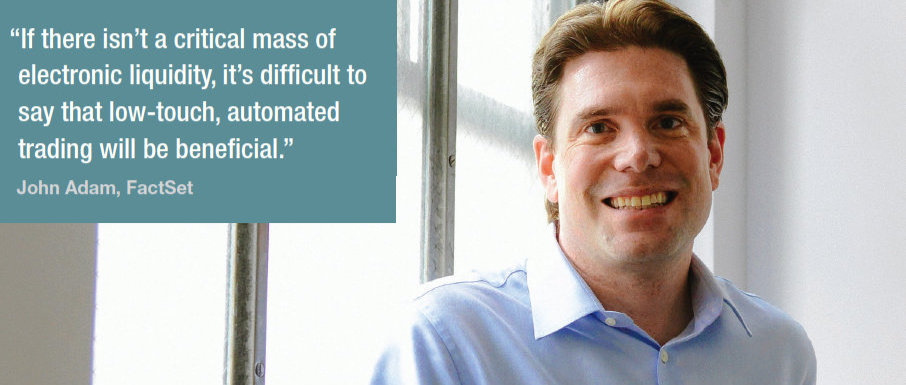 “There are practical reasons why fixed income has been harder to automate,” says John Adam, global director of portfolio management and trading solutions at FactSet. “Portfolio managers may only know the characteristics of the bond they’re looking for, perhaps one that can meet a certain duration or yield to maturity. This in turn means a more complex workflow, first determining what bonds are available that match the characteristics and then pricing the best fit for the portfolio. Additionally, if there isn’t a critical mass of electronic liquidity, it’s difficult to say that low-touch, automated trading will be beneficial.”
“There are practical reasons why fixed income has been harder to automate,” says John Adam, global director of portfolio management and trading solutions at FactSet. “Portfolio managers may only know the characteristics of the bond they’re looking for, perhaps one that can meet a certain duration or yield to maturity. This in turn means a more complex workflow, first determining what bonds are available that match the characteristics and then pricing the best fit for the portfolio. Additionally, if there isn’t a critical mass of electronic liquidity, it’s difficult to say that low-touch, automated trading will be beneficial.”
Splitting the orders
To support this model, the workflow needs careful consideration, to ensure that trades are not misdirected creating additional risk.
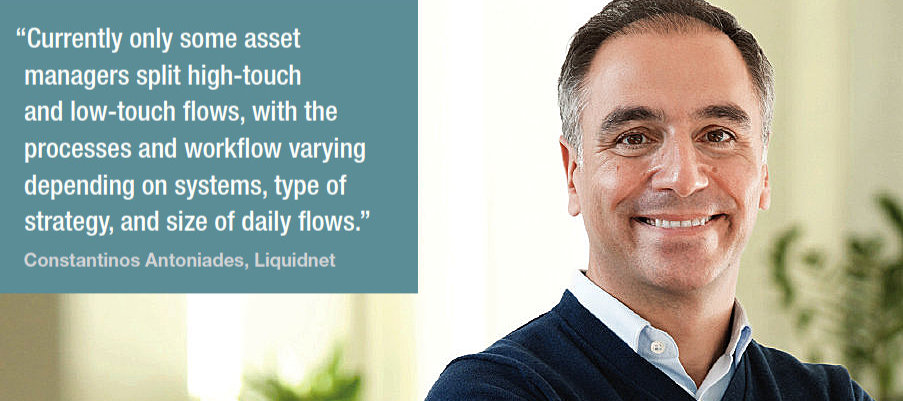 Constantinos Antoniades, head of fixed income at Liquidnet notes, “Currently only some asset managers split high-touch and low-touch flows, with the processes and workflow varying depending on systems, type of strategy, and size of daily flows. Some have a systematic and automated low-touch/high-touch flow segmentation based on set criteria, some have all orders start at the high-touch desk which will then direct certain orders to the low-touch desk, and some have certain strategies fully executed by the low-touch desk.”
Constantinos Antoniades, head of fixed income at Liquidnet notes, “Currently only some asset managers split high-touch and low-touch flows, with the processes and workflow varying depending on systems, type of strategy, and size of daily flows. Some have a systematic and automated low-touch/high-touch flow segmentation based on set criteria, some have all orders start at the high-touch desk which will then direct certain orders to the low-touch desk, and some have certain strategies fully executed by the low-touch desk.”
Wellington Management, for example, has four trading lines: high touch equities, high touch macro trading which includes cash bonds, emerging debt, currencies and rates, a credit desk comprising high yield and investment grade and structured products, and a cross-asset electronic desk. The latter is where it aims to optimise flow across all instruments and all asset classes. Employing technology and data, the fund manager is able to segment the flow more effectively, to dynamically monitor and measure the trade and then post trade, take the lessons learnt and feed it back into its pre-trade model.
T. Rowe Price has desk specialists who manage specific asset classes such as high yield, investment grade, emerging markets, structured products, and money markets. They work in partnership with the low touch team that automates orders via algos and other tools.
Not all asset managers believe the roles require separate desks. Firms such as Eaton Vance and Candriam Asset Management employ traders who can manage low-touch trading as part of their roles managing other asset classes.
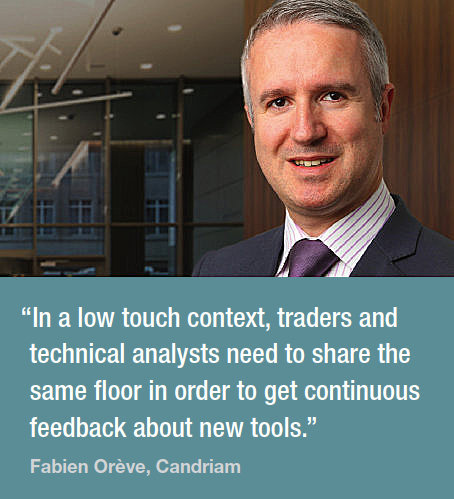 “The low-touch trading solutions for currencies, exchange-traded funds (ETF) and listed derivatives at the multi-asset desk have created economies of scale and synergies between equity and fixed-income traders,” says Fabien Orève, global head of trading at Candriam. “Equity and fixed income traders have become increasingly multi-skilled and productive when they add currencies, ETFs and listed derivatives to their day-to-day workflow,” he adds.
“The low-touch trading solutions for currencies, exchange-traded funds (ETF) and listed derivatives at the multi-asset desk have created economies of scale and synergies between equity and fixed-income traders,” says Fabien Orève, global head of trading at Candriam. “Equity and fixed income traders have become increasingly multi-skilled and productive when they add currencies, ETFs and listed derivatives to their day-to-day workflow,” he adds.
Candriam, T. Rowe Price and other asset managers also advocate having technology experts either at the multi asset class trading desk or in close proximity.
“In a low touch context, traders and technical analysts need to share the same floor in order to get continuous feedback about new tools,” says Orève. “Traders have to support the development of technology and test the different pieces that are put together into the order execution management system (O/EMS).
Technology under the workflow
To provide the triage needed to separate orders between execution styles, trading desks need to have the right order and execution management systems to reduce manual intervention in the workflow. To date, connectivity between systems has sometimes been limited.
 Adam Toms, CEO of desktop connectivity provider OpenFin, says “[Firms] should give careful consideration to the shape of their trading desks, identify the components that can be interconnected and their ability to leverage big data in order to provide the insights they need in real time which can help traders refine their tactics as they work the order.”
Adam Toms, CEO of desktop connectivity provider OpenFin, says “[Firms] should give careful consideration to the shape of their trading desks, identify the components that can be interconnected and their ability to leverage big data in order to provide the insights they need in real time which can help traders refine their tactics as they work the order.”
While an OMS is useful internally to route the order to the right desk, low-touch trading requires the trade to be routed and then feedback on the execution captured and brought back to the trader, which is the role of the EMS.
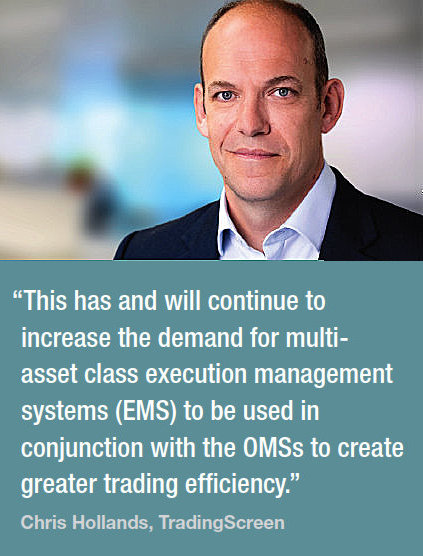 “This has and will continue to increase the demand for multi-asset class execution management systems (EMS) to be used in conjunction with the OMSs to create greater trading efficiency,” says Chris Hollands, head of North American and European sales and account management at TradingScreen.
“This has and will continue to increase the demand for multi-asset class execution management systems (EMS) to be used in conjunction with the OMSs to create greater trading efficiency,” says Chris Hollands, head of North American and European sales and account management at TradingScreen.
Orève believes the higher level of customisation of O/EMS has greatly facilitated the integration of low-touch workflow with high-touch trading teams “The multi-asset O/EMS helps buy-side traders, regardless of their expertise, gain visibility across all asset classes, filter orders by level of difficulty and select low-touch trading solutions for the easiest orders,” he adds.
Buy-side firms are also being helped in their drive to automate by trading platforms. For example, bond-trading market operators Tradeweb’s AiEX and MarketAxess’ Auto-Execution tools have seen increasing growth (see p.48) which have assisted in the automation of fixed income. Sell-side firms and ETF market makers are streaming firm prices in bond markets to clients which they can use to feed execution algorithms.
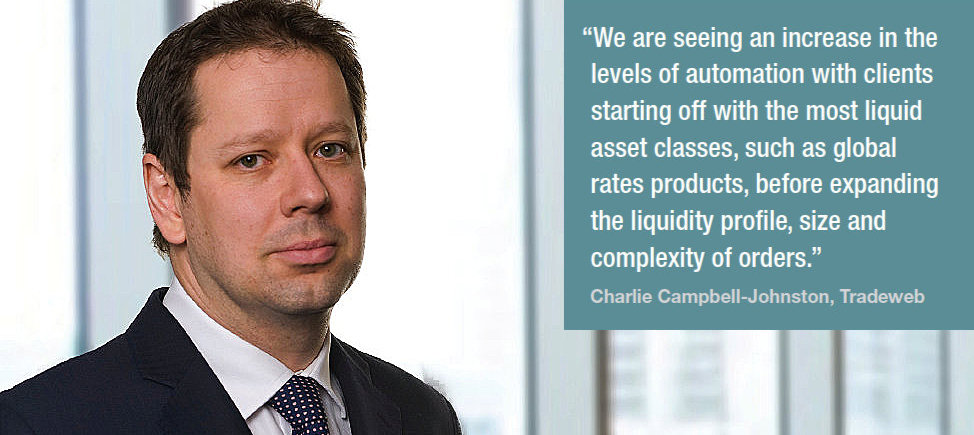 “We are seeing an increase in the levels of automation with clients starting off with the most liquid asset classes, such as global rates products, before expanding the liquidity profile, size and complexity of orders,” says Charlie Campbell-Johnston, head of integration and workflow solutions at Tradeweb. “We are doing a lot of work with clients to help them understand how they can configure the rules in accordance with their objectives across each profile of order, whether it’s rates, credit, derivatives or ETFs”.
“We are seeing an increase in the levels of automation with clients starting off with the most liquid asset classes, such as global rates products, before expanding the liquidity profile, size and complexity of orders,” says Charlie Campbell-Johnston, head of integration and workflow solutions at Tradeweb. “We are doing a lot of work with clients to help them understand how they can configure the rules in accordance with their objectives across each profile of order, whether it’s rates, credit, derivatives or ETFs”.
©The DESK 2019
©Markets Media Europe 2025












